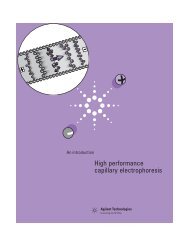Improvements in Deuterium Lamps Maximize HPLC ... - T.E.A.M.
Improvements in Deuterium Lamps Maximize HPLC ... - T.E.A.M.
Improvements in Deuterium Lamps Maximize HPLC ... - T.E.A.M.
You also want an ePaper? Increase the reach of your titles
YUMPU automatically turns print PDFs into web optimized ePapers that Google loves.
<strong>Improvements</strong> <strong>in</strong> <strong>Deuterium</strong><strong>Lamps</strong> <strong>Maximize</strong> <strong>HPLC</strong> SystemPerformance• Longer lamp life• Six- to ten-fold <strong>in</strong>crease <strong>in</strong> sensitivity• A PerfectFit with the Agilent 1100Series <strong>HPLC</strong> l<strong>in</strong>eBy Erich WagnerProduct Manager—<strong>HPLC</strong> ConsumablesThe Agilent 1100 Series <strong>HPLC</strong> as wellas the 1050 and 1090 systems arefound <strong>in</strong> analytical laboratoriesaround the globe, serv<strong>in</strong>g <strong>in</strong>dustriesthat depend on reliable and reproducibleresults—particularly at lowlevels of detection. However, mostanalysts do not realize that thedetector lamp they <strong>in</strong>stall can makea significant difference <strong>in</strong> their overallsystem performance.Lamp <strong>Improvements</strong> for the Agilent1100 Detectors Provide Long LifetimePlus Enhanced System Sensitivity—Lamp Life Extended by 50%The lifetime of detector lamps forthe Agilent 1100 <strong>HPLC</strong> <strong>in</strong>strumentis extended by apply<strong>in</strong>g a consistentand thick coat<strong>in</strong>g on the lamp cathode.Figure 1 shows the differencebetween a cathode <strong>in</strong> an improvedAgilent lamp versus a popular competitorlamp. The unique Agilentproprietary process forms a highdensity, uniform coat<strong>in</strong>g on the cathodewithout notable darkened areas.In contrast, there are observabledarkened areas along the Brand Xcathode. Darkened areas representbreaks <strong>in</strong> the cathode coat<strong>in</strong>g andcause shorter lamp lifetime. In fact,the new coat<strong>in</strong>g process <strong>in</strong>creasesAgilent 1100 lamp lifetimes up to50%. In addition, improvements <strong>in</strong>the cathode coat<strong>in</strong>g also result <strong>in</strong> amore consistent lamp-to-lamp voltageand therefore a more consistentFigure 1. A Consistent Coat<strong>in</strong>g on theAgilent Cathode Extends Lamp LifetimeDarkened areas along the Brand X cathoderepresent breaks <strong>in</strong> the cathode coat<strong>in</strong>g thatshorten lamp lifetime.Agilent CathodeBrand X Cathodelamp-to-lamp signal. These improvementsalso enhance the sensitivityof the Agilent 1100 <strong>in</strong>strument.The same cathode improvementsdescribed above have been appliedto the lamps for the Agilent 1090 and1050 Series Diode Array Detectors(DAD) and the 1050 MultipleWavelength Detector (MWD). Aga<strong>in</strong>,this proprietary coat<strong>in</strong>g processextends these lamp lifetimes by upto 50%.Increased Signal-to-Noise RatioMost commercially available deuteriumlamps are manufactured with a1.0 mm aperture. Agilent deuteriumlamps for the 1100 Series <strong>HPLC</strong> aredesigned with a much narroweraperture, which provides <strong>in</strong>creasedlight <strong>in</strong>tensity and decreased noise,translat<strong>in</strong>g <strong>in</strong>to an appreciablyhigher signal-to-noise ratio. Theseimprovements <strong>in</strong> overall sensitivityare possible only if the apertureis aligned properly <strong>in</strong> the <strong>HPLC</strong>detection system. Without properalignment, potential ga<strong>in</strong>s <strong>in</strong>sensitivity cannot be realized.www.agilent.com/chem Separation Times Volume 16 Number 1 200317
<strong>Improvements</strong> <strong>in</strong> <strong>Deuterium</strong> <strong>Lamps</strong>Cont<strong>in</strong>ued from page 17Through <strong>in</strong>novative design and constructionsteps, Agilent DAD andMWD longlife deuterium lamps arealigned precisely dur<strong>in</strong>g the manufactur<strong>in</strong>gprocess. A computercontrols positions and permanentlysecures the glass bulb of the lamp<strong>in</strong>to the alum<strong>in</strong>um mount<strong>in</strong>g-r<strong>in</strong>g,thereby creat<strong>in</strong>g a pre-alignedproduct for the Agilent 1100 <strong>HPLC</strong><strong>in</strong>strument. The PerfectFit f<strong>in</strong>alproduct is not only optimized forperformance, but the lamp is easierto handle dur<strong>in</strong>g both <strong>in</strong>stallationand removal.Sh<strong>in</strong>e-Through <strong>Deuterium</strong> <strong>Lamps</strong> forHigh-Intensity UV-Vis WavelengthsSh<strong>in</strong>e-Through <strong>Deuterium</strong> lamps forthe Agilent 1100 are constructedso that essentially two lamps—oneultraviolet and the other visible—areplaced <strong>in</strong> series, provid<strong>in</strong>g a high<strong>in</strong>tensity broad-spectrum operat<strong>in</strong>grange of 200 to 800 nm.A Ten-Fold Increase <strong>in</strong> SensitivityThe overall <strong>in</strong>crease <strong>in</strong> sensitivityga<strong>in</strong>ed when select<strong>in</strong>g an AgilentSh<strong>in</strong>e-Through <strong>Deuterium</strong> lamp withan Agilent 1100 could be as high astenfold. This is demonstrated <strong>in</strong>Figure 2, which compares a separationof lysozyme us<strong>in</strong>g an AgilentSh<strong>in</strong>e-Through <strong>Deuterium</strong> lamp withthe same separation conductedus<strong>in</strong>g a deuterium lamp not made toAgilent specifications. Whether operat<strong>in</strong>g<strong>in</strong> the ultraviolet region at 214nm or at 280 nm, the differences arestrik<strong>in</strong>g. Both lamps easily detect thema<strong>in</strong> component at approximately13.2 m<strong>in</strong>utes, but only the Agilentlamp on this absorbance scale clearlydetects the low-level impuritiesFigure 2. Lamp Selection Impacts Chromatographic Performance–Separation ofLysozyme and its ImpuritiesImpurity peaks at retention times greater than 16 m<strong>in</strong>utes are clearly present when the <strong>in</strong>strumentis configured with the Agilent lamp.mAU200150100500-50mAU200150100500-50mAU1512.5107.552.50-2.5mAU1512.5107.552.50-2.5Agilent Sh<strong>in</strong>e-Through<strong>Deuterium</strong> Lamp at 214 nm0 2.5 5 7.5 10 12.5 15 17.5 20 m<strong>in</strong>(Time)Non-Agilent Lamp at 214 nm0 2.5 5 7.5 10 12.5 15 17.5 20 m<strong>in</strong>(Time)Agilent Sh<strong>in</strong>e-Through<strong>Deuterium</strong> Lamp at 280 nm0 2.5 5 7.5 10 12.5 15 17.5 20 m<strong>in</strong>Non-Agilent Lamp at 280 nm(Time)Clear detectionof low-levelimpurity peaksPoor impurityidentificationClear detectionof low-levelimpurity peaksPoor impurityidentification0 2.5 5 7.5 10 12.5 15 17.5 20 m<strong>in</strong>(Time)13.1513.1713.1513.1718.5718.9218.5718.9220.7120.71O R D E RG U I D EInstrument/Detector Lamp Type Part Number1100 Series DAD/MWD Sh<strong>in</strong>e-Through <strong>Deuterium</strong> 2140-05901100 Series DAD/MWD Long-Life, Sh<strong>in</strong>e-Through <strong>Deuterium</strong> 5181-15301090 Series Diode Array Detector (DAD) <strong>Deuterium</strong> 79883-600021050 Series Diode Array Detector <strong>Deuterium</strong> 79883-600021050 Series Multiple Wavelength <strong>Deuterium</strong> 79883-60002Detector (MWD)18 Separation Times Volume 16 Number 1 2003 www.agilent.com/chem
<strong>Improvements</strong> <strong>in</strong> <strong>Deuterium</strong> <strong>Lamps</strong>Cont<strong>in</strong>ued from page 18hav<strong>in</strong>g retention times between16 and 20 m<strong>in</strong>utes <strong>in</strong> this sample.Expand<strong>in</strong>g the absorbance scale forthis peptide separation at 214 nmclearly shows that the Agilent lampprovides a six- to ten-fold highersignal-to-noise ratio than the non-Agilent lamp (see Figure 3). Byprovid<strong>in</strong>g higher sensitivity, Agilentlamps can extend detection capabilitiesand improve quantification attrace levels—for more than 2,000hours of use.Performance TestsWe also tested four lamps, each froma different manufacturer, for alignmenttolerance and noise follow<strong>in</strong>gthe ASTM protocol. The follow<strong>in</strong>gtable summarizes the results of thesetests. None of the four lamps testedwere correctly aligned for theAgilent 1100 <strong>in</strong>strument; all hadalignment tolerances greater than100% and noise levels were high—upto 20 times higher than Agilent specificationsfor the wavelengths listedthe table.PerfectFit Agilent <strong>Lamps</strong>Agilent deuterium lamps are differentand better because they arespecifically designed to last longerand to provide enhanced sensitivitywhen us<strong>in</strong>g the Agilent 1100 as wellas the 1090 and 1050 Series <strong>HPLC</strong>l<strong>in</strong>e.Figure 3. Agilent <strong>Lamps</strong> Are Optimized to <strong>Maximize</strong> Sensitivity–Separationof Lysozyme and its Impurities (expanded scale) at 214 nmPerfectFit Agilent lamps, with <strong>in</strong>creased signal-to-noise, provide <strong>in</strong>creased sensitivity,precision, and accuracy at low levels.mAU605550454035mAU605550454035Agilent Lamp at 214 nm116.5816 17 18 19 20 m<strong>in</strong>(Time)Non-Agilent Lamp at 214 nm116.58Peak 1 S/N = 150Peak 2 S/N = 400Peak 3 S/N = 300Peak 1 S/N = 15Peak 2 S/N = 50Peak 3 S/N = 5016 17 18 19 20 m<strong>in</strong>(Time)For More InformationVisit www.agilent.com/chemand click “Library” then enterpublication 5980-2372E <strong>in</strong>the keyword field and click“Search.” Or ask your localAgilent sales representativefor additional <strong>in</strong>formation.Improved S/Nensures detectionof all impuritiesNo impuritydetected218.57218.5718.92320.71320.7120.9420.94Performance Tests F<strong>in</strong>d Competitor Lamp Performance Outside SpecificationsAll of these non-Agilent lamps were outside noise level and alignment specifications (>100%).Non-Agilent Lamp Alignment Tolerance (%) ASTM Noise <strong>in</strong> mAU measured at:Measurement x-dir y-dir z-dir 254 nm 750 nm 254 nm 750 nm 254 nmAgilent Specifications 100% 100% 100%
















